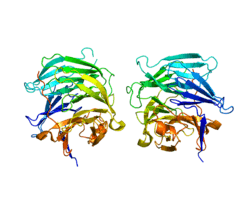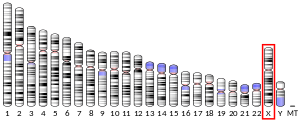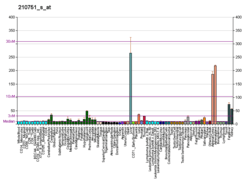Regucalcin
Regucalcin is a protein that in humans is encoded by the RGN gene[5][6][7]
The protein encoded by this gene is a highly conserved, calcium-binding protein, that is preferentially expressed in the liver, kidney and other tissues.[8][9][10][11] It may have an important role in calcium homeostasis. Studies in rats indicate that this protein may also play a role in aging, as it shows age-associated down-regulation. This gene is part of a gene cluster on chromosome Xp11.3-Xp11.23. Alternative splicing results in two transcript variants having different 5' UTRs, but encoding the same protein.[7]
Regucalcin is a proposed name for a calcium-binding protein that was discovered in 1978 [12][13][14][15] This protein is also known as Senescence Marker Protein-30 (SMP30).[16][17] Regucalcin differs from calmodulin and other Ca2+-related proteins as it does not contain an EF-hand motif of Ca2+-binding domain.[13][18] It may regulate the effect of Ca2+ on liver cell functions.[15] From many investigations, regucalcin has been shown to play a multifunctional role in many cell types as a regulatory protein in the intracellular signaling system.
Gene
Regucalcin and its gene (rgn) are identified in 16 species consisting of regucalcin family.[11][18] Regucalcin is greatly expressed in the liver of rats, although the protein is found in small amounts in other tissues and cells. The rat regucalcin gene consists of seven exons and six introns, and several consensus regulatory elements exist upstream of the 5’-flanking region.[19] The gene is localized on the proximal end of rat chromosome Xq11.1-12 and human Xp11.3-Xp11.23. AP-1, NFI-A1, RGPR-p117, and Wnt/β-catenin/TCF4 can bind to the promoter region of the rat regucalcin gene to mediate the Ca2+ and other signaling responses with various hormones and cytokines for transcriptional activation.[20]
Function
Regucalcin plays a pivotal role in the keep of intracellular Ca2+ homeostasis due to activating Ca2+ pump enzymes in the plasma membrane (basolateral membrane), microsomes (endoplasmic reticulum) and mitochondria of many cells. Regucalcin is localized in the cytoplasm, mitochondria, microsomes and nucleus. Regucalcin is translocated from cytoplasm to nucleus with hormone stimulation. Regucalcin has a suppressive effect on calcium signaling from the cytoplasm to the nucleus in the proliferative cells. Also, regucalcin has been demonstrated to transport into the nucleus of cells, and it can inhibit nuclear protein kinase, protein phosphatase, and deoxyribonucleic acid and ribonucleic acid synthesis. Regucalcin can control enhancement of cell proliferation due to hormonal stimulation. Moreover, regucalcin has been shown to have an inhibitory effect on aminoacyl t-RNA synthetase, a rate limiting enzyme at translational process of protein synthesis and an activatory effect on cystein protease and superoxide dismutase in liver and kidney cells.
Regucalcin is expressed in the neuron of brain tissues, and the decrease of brain regucalcin causes accumulation of calcium in the brain microsomes. Regucalcin has an inhibitory effect on protein kinase and protein phosphatase activity dependent on Ca signaling. Regucalcin has been shown to have an activatory effect on Ca pumping enzyme (Ca-ATPase) in heart sarcoplasmic reticulum. Regucalcin plays a role in the promotion of urinary calcium transport in the epithelial cells of kidney cortex. Overexpression of regucalcin suppresses cell death and apoptosis in the cloned rat hepatoma cells and normal rat kidney epithelial cells (NRK52E) induced by various signaling factors.
Thus, regucalcin plays a multifunctional role in the regulation of cell functions in liver, kidney cortex, heart and brain. Thus, regucalcin plays a pivotal role in keep of cell homeostasis and function.[21] Regucalcin plays a pivotal role as a suppressor protein for cell signaling systems in many cell types.
Pathophysiologic role
Overexpressing of regucalcin in rats (transgenic rats) has been shown to induce bone loss and hyperlipidemia with increasing age, indicating a pathophysiologic role. Regucalcin transgenic rat may be a useful tool as animal model in osteoporosis and hyperlipidemia.[22] Also, regucalcin/SMP30-knockout mice are known to induce a suppression in ascorbic acid biosynthesis. The disorder of regucalcin expression has been proposed to be induced cancer, brain function, heart injury, kidney failure, osteoporosis, and hyperlipidemia.[23][24]. Regucalcin plays a novel role as a suppressor in carcinogenesis of human patients with various types of cancer including pancreatic cancer, breast cancer, hepatoma, and lung cancer.[25][26][23] Of note, it has been conducted a systematic search to identify biomarker candidates for a frailty biomarker panel. Gene expression databases were to identify genes regulated in aging, longevity, and age-related diseases with a focus on secreted factors or molecules detectable in body fluids as potential frailty biomarkers. A total of 44 markers were evaluated in the seven categories listed above, and 19 were awarded a high priority score, 22 identified as medium priority and three were low priority. In each category high and medium priority markers were identified. Regucalcin (RGN) was proposed to be a core gene (protein) with high priority of frailty biomarkers in order to ascertain their diagnostic, prognostic and therapeutic potential.[27]. Notably, it has been shown that epigenetic modifications of survivin and regucalcin in non-small cell lung cancer tissues contribute to malignancy.[28]
References
- GRCh38: Ensembl release 89: ENSG00000130988 - Ensembl, May 2017
- GRCm38: Ensembl release 89: ENSMUSG00000023070 - Ensembl, May 2017
- "Human PubMed Reference:". National Center for Biotechnology Information, U.S. National Library of Medicine.
- "Mouse PubMed Reference:". National Center for Biotechnology Information, U.S. National Library of Medicine.
- Shimokawa N, Matsuda Y, Yamaguchi M (October 1995). "Genomic cloning and chromosomal assignment of rat regucalcin gene". Molecular and Cellular Biochemistry. 151 (2): 157–63. doi:10.1007/BF01322338. PMID 8569761.
- Fujita T, Mandel JL, Shirasawa T, Hino O, Shirai T, Maruyama N (September 1995). "Isolation of cDNA clone encoding human homologue of senescence marker protein-30 (SMP30) and its location on the X chromosome". Biochimica et Biophysica Acta (BBA) - Gene Structure and Expression. 1263 (3): 249–52. doi:10.1016/0167-4781(95)00120-6. PMID 7548213.
- "Entrez Gene: RGN regucalcin (senescence marker protein-30)".
- Yamaguchi M, Isogai M, Kato S, Mori S (June 1991). "Immunohistochemical demonstration of calcium-binding protein regucalcin in the tissues of rats: the protein localizes in liver and brain". Chemical & Pharmaceutical Bulletin. 39 (6): 1601–3. doi:10.1248/cpb.39.1601. PMID 1934180.
- Shimokawa N, Yamaguchi M (June 1992). "Calcium administration stimulates the expression of calcium-binding protein regucalcin mRNA in rat liver". FEBS Letters. 305 (2): 151–4. doi:10.1016/0014-5793(92)80884-J. PMID 1618342.
- Yamaguchi M, Isogai M (May 1993). "Tissue concentration of calcium-binding protein regucalcin in rats by enzyme-linked immunoadsorbent assay". Molecular and Cellular Biochemistry. 122 (1): 65–8. doi:10.1007/BF00925738. PMID 8350865.
- Misawa H, Yamaguchi M (August 2000). "The gene of Ca2+-binding protein regucalcin is highly conserved in vertebrate species". International Journal of Molecular Medicine. 6 (2): 191–6. doi:10.3892/ijmm.6.2.191. PMID 10891565.
- Yamaguchi M, Yamamoto T (June 1978). "Purification of calcium binding substance from soluble fraction of normal rat liver". Chemical & Pharmaceutical Bulletin. 26 (6): 1915–8. doi:10.1248/cpb.26.1915. PMID 699201.
- Yamaguchi M, Sugii K (February 1981). "Properties of calcium-binding protein isolated from the soluble fraction of normal rat liver". Chemical & Pharmaceutical Bulletin. 29 (2): 567–70. doi:10.1248/cpb.29.567. PMID 7273253.
- Yamaguchi M, Mori S (January 1988). "Effect of Ca2+ and Zn2+ on 5'-nucleotidase activity in rat liver plasma membranes: Hepatic calcium-binding protein (regucalcin) reverses the Ca2+ effect". Chemical & Pharmaceutical Bulletin. 36 (1): 321–325. doi:10.1248/cpb.36.321. PMID 2837338.
- Yamaguchi M (1992). "A novel Ca2+-binding protein regucalcin and calcium inhibition. Regulatory role in liver cell function". Calcium Inhibition. Boca Raton: CRC Press. pp. 19–41.
- Fujita T, Uchida K, Maruyama N (April 1992). "Purification of senescence marker protein-30 (SMP30) and its androgen-independent decrease with age in the rat liver". Biochimica et Biophysica Acta (BBA) - General Subjects. 1116 (2): 122–8. doi:10.1016/0304-4165(92)90108-7. PMID 1581340.
- Fujita T, Shirasawa T, Uchida K, Maruyama N (October 1992). "Isolation of cDNA clone encoding rat senescence marker protein-30 (SMP30) and its tissue distribution". Biochimica et Biophysica Acta (BBA) - Gene Structure and Expression. 1132 (3): 297–305. doi:10.1016/0167-4781(92)90164-u. PMID 1420310.
- Shimokawa N, Yamaguchi M (August 1993). "Molecular cloning and sequencing of the cDNA coding for a calcium-binding protein regucalcin from rat liver". FEBS Letters. 327 (3): 251–5. doi:10.1016/0014-5793(93)80998-a. PMID 8348951.
- Yamaguchi M, Makino R, Shimokawa N (December 1996). "The 5' end sequences and exon organization in rat regucalcin gene". Molecular and Cellular Biochemistry. 165 (2): 145–50. doi:10.1007/bf00229476. PMID 8979263.
- Yamaguchi M (January 2011). "The transcriptional regulation of regucalcin gene expression". Molecular and Cellular Biochemistry. 346 (1–2): 147–71. doi:10.1007/s11010-010-0601-8. PMID 20936536.
- Yamaguchi M (March 2005). "Role of regucalcin in maintaining cell homeostasis and function (review)". International Journal of Molecular Medicine. 15 (3): 371–89. doi:10.3892/ijmm.15.3.371. PMID 15702226.
- Yamaguchi M (August 2010). "Regucalcin and metabolic disorders: osteoporosis and hyperlipidemia are induced in regucalcin transgenic rats". Molecular and Cellular Biochemistry. 341 (1–2): 119–33. doi:10.1007/s11010-010-0443-4. PMID 20349117.
- Yamaguchi M (2017). The Role of Regucalcin in Cell Homeostasis and Disorder. New York: Nova Science Publishers. pp. 1–288. ISBN 978-3-319-39855-6.
- Yamaguchi M, ed. (2019). Regucalcin: Metabolic Regulation and Disease. New York: Nova Science Publishers. pp. 1–176. ISBN 978-1536161724.
- Yamaguchi M (August 2015). "Involvement of regucalcin as a suppressor protein in human carcinogenesis: Insight into the gene therapy". Journal of Cancer Research and Clinical Oncology. 141 (8): 133–1341. doi:10.1007/s00432-014-1831-z. PMID 25230901.
- Yamaguchi M, Osuka S, Weitzmann MN, El-Rayes BF, Shoji M, Murata T (May 2016). "Prolonged survival in pancreatic cancer patients with increased regucalcin gene expression: Overexpression of regucalcin suppresses the proliferation in human pancreatic cancer MIA PaCa-2 cells in vitro". International Journal of Oncology. 48 (5): 1955–1964. doi:10.3892/ijo.2016.3409. PMID 26935290.
- Cardosoa AL, Fernandes A, Aguilar-Pimentelc JA, de Angelisd MH, Guedes JR, Britob MA, Ortolano S, Pani G, Athanasopoulou S, Gonos ES, Schosserer M, Grillari J, Peterson P, Tuna BG, Dogan S, Meyer A, van Os R, Trendelenburg AU (July 2018). "Towards frailty biomarkers: Candidates from genes and pathways regulated in aging and age-related diseases". Journal of Cancer Research and Clinical Oncology. 47: 214–277. doi:10.1016/j.arr.2018.07.004. PMID 30071357.
- Nitschkowski D, Marwitz S, Kotanidou SA, Reck M, Kugler C, Rabe KF, Ammerpohl O, Goldmann T (November 2019). "Live and let die: epigenetic modifications of Survivin and Regucalcin in non-small cell lung cancer tissues contribute to malignancy". Clinical Epigenetics. 11 (1): 157. doi:10.1186/s13148-019-0770-6. PMC 6852724. PMID 31718698.
Further reading
- Yamaguchi M (September 1998). "Role of calcium-binding protein regucalcin in regenerating rat liver". Journal of Gastroenterology and Hepatology. 13 Suppl (Supplement): S106–12. doi:10.1111/jgh.1998.13.s1.106. PMID 9792043.
- Fujita T, Shirasawa T, Inoue H, Kitamura T, Maruyama N (September 1998). "Hepatic and renal expression of senescence marker protein-30 and its biological significance". Journal of Gastroenterology and Hepatology. 13 Suppl (Supplement): S124–31. doi:10.1111/jgh.1998.13.s1.124. PMID 9792046.
- Yamaguchi M (March 2000). "Role of regucalcin in calcium signaling". Life Sciences. 66 (19): 1769–80. doi:10.1016/S0024-3205(99)00602-5. PMID 10809175.
- Yamaguchi M (September 2000). "The role of regucalcin in nuclear regulation of regenerating liver". Biochemical and Biophysical Research Communications. 276 (1): 1–6. doi:10.1006/bbrc.2000.3359. PMID 11006072.
- Fujita T, Shirasawa T, Maruyama N (March 1999). "Expression and structure of senescence marker protein-30 (SMP30) and its biological significance". Mechanisms of Ageing and Development. 107 (3): 271–80. doi:10.1016/S0047-6374(98)00136-5. PMID 10360682.
- Laurentino SS, Correia S, Cavaco JE, Oliveira PF, de Sousa M, Barros A, Socorro S (April 2012). "Regucalcin, a calcium-binding protein with a role in male reproduction?". Molecular Human Reproduction. 18 (4): 161–70. doi:10.1093/molehr/gar075. PMID 22121208.
- Yamaguchi M (August 2012). "Role of regucalcin in brain calcium signaling: involvement in aging". Integrative Biology. 4 (8): 825–37. doi:10.1039/c2ib20042b. PMID 22652898.
- Yamaguchi M, Murata T (August 2013). "Involvement of regucalcin in lipid metabolism and diabetes". Metabolism. 62 (8): 1045–51. doi:10.1016/j.metabol.2013.01.023. PMID 23453039.
- Yamaguchi M (June 2013). "Suppressive role of regucalcin in liver cell proliferation: involvement in carcinogenesis". Cell Proliferation. 46 (3): 243–53. doi:10.1111/cpr.12036. PMC 6496855. PMID 23692083.
- Yamaguchi M (October 2013). "The anti-apoptotic effect of regucalcin is mediated through multisignaling pathways". Apoptosis. 18 (10): 1145–53. doi:10.1007/s10495-013-0859-x. PMC 3775152. PMID 23670020.
- Yamaguchi M (November 2013). "Role of regucalcin in cell nuclear regulation: involvement as a transcription factor". Cell and Tissue Research. 354 (2): 331–41. doi:10.1007/s00441-013-1665-z. PMID 23793546.
- Marques R, Maia CJ, Vaz C, Correia S, Socorro S (January 2014). "The diverse roles of calcium-binding protein regucalcin in cell biology: from tissue expression and signalling to disease". Cellular and Molecular Life Sciences. 71 (1): 93–111. doi:10.1007/s00018-013-1323-3. PMID 23519827.
- Yamaguchi M (March 2014). "The role of regucalcin in bone homeostasis: involvement as a novel cytokine". Integrative Biology. 6 (3): 258–66. doi:10.1039/c3ib40217g. PMID 24458249.
- Yamaguchi M (May 2014). "Regulatory role of regucalcin in heart calcium signaling: Insight into cardiac failure (Review)". Biomedical Reports. 2 (3): 303–308. doi:10.3892/br.2014.245. PMC 3990221. PMID 24748964.
- Yamaguchi M (June 2014). "Regucalcin as a potential biomarker for metabolic and neuronal diseases". Molecular and Cellular Biochemistry. 391 (1–2): 157–66. doi:10.1007/s11010-014-1998-2. PMID 24599745.
- Yamaguchi M (November 2015). "The potential role of regucalcin in kidney cell regulation: Involvement in renal failure (Review)". International Journal of Molecular Medicine. 36 (5): 1191–9. doi:10.3892/ijmm.2015.2343. PMID 26398287.
- Vaz CV, Correia S, Cardoso HJ, Figueira MI, Marques R, Maia CJ, Socorro S (July 2016). "The Emerging Role of Regucalcin as a Tumor Suppressor: Facts and Views". Current Molecular Medicine. 16 (7): 607–619. doi:10.2174/1566524016666160714124550. PMID 27411833.





